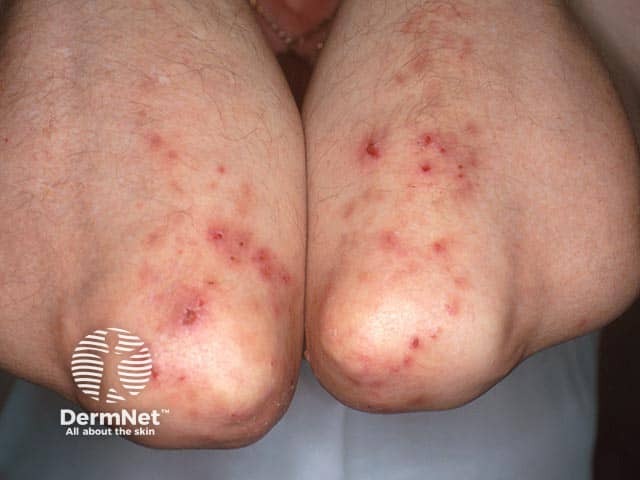Contributors

Dr Amy Stanway
Dermatologist at Bethlehem Skin Clinic
Subscribe to our newsletter
Thank you! Your submission has been received!
Oops! Something went wrong while submitting the form.


Coeliac disease is an autoimmune condition that affects around 1 in 70 New Zealanders with women being diagnosed more frequently than men. While it primarily affects the digestive system by damaging the lining of the small intestine, its impact can be seen far beyond the gut -including on the skin.
Skin conditions in coeliac disease may arise from nutritional deficiencies or inflammation caused by the autoimmune process. For women, who already face unique hormonal and nutritional challenges throughout life - from menstruation to menopause - these effects can be even more pronounced. Here’s what you need to know about the skin-related manifestations of coeliac disease and their relevance to women’s health.
What is it and what does it look like?
Dermatitis herpetiformis (DH) is a direct skin manifestation of gluten intolerance and is strongly linked to coeliac disease. It presents as an intensely itchy, blistering rash typically affecting the elbows, knees, buttocks, scalp, and shoulders. While it’s technically a blistering disease, intact blisters are rarely seen because the intense itching leads to scratching and breaking of the blisters. As a result, the rash often appears as clusters of small, scabby sores that can resemble eczema.
Although the name “herpetiformis” suggests a connection to the herpes virus (due to the blistering appearance), the condition has no link to herpes.

Who gets it?
DH can affect both men and women but is more commonly diagnosed in men. That said, women often experience delayed or misdiagnosed symptoms due to the subtle and overlapping nature of autoimmune disorders. On average, DH develops in people aged 40–50, but it can occur at any age.
The condition has a genetic predisposition, with most patients carrying specific HLA gene subtypes (HLA-DQ2 or HLA-DQ8). While DH isn’t passed directly through families, people with a family history of coeliac disease or other autoimmune disorders - more commonly seen in women - are at increased risk.
Diagnosis and treatment
Diagnosing DH involves clinical evaluation by a dermatologist, confirmed by skin biopsies and blood tests. It’s essential to distinguish DH from other conditions such as eczema, scabies, or autoimmune blistering diseases.
Treatment includes a lifelong strict gluten-free diet, which helps heal the skin and gut over time. However, symptom relief may take months or even up to two years. To control the severe itching, medications like dapsone are often prescribed, though long-term use requires careful medical monitoring due to potential side effects.
Importantly, untreated DH not only affects quality of life but also increases the risk of intestinal lymphoma - a rare cancer associated with coeliac disease. This makes adherence to a gluten-free diet essential for long-term health, particularly in women who may be more susceptible to autoimmune complications.
Nutritional deficiencies and skin health
Women with undiagnosed or poorly managed coeliac disease are at risk of nutrient deficiencies - especially iron, zinc, and B vitamins - due to impaired absorption in the gut.
These deficiencies can result in:
For women in their reproductive years, iron deficiency may worsen due to menstrual blood loss, compounding skin-related symptoms.
Autoimmune skin conditions
Women with coeliac disease are more prone to other autoimmune diseases, many of which can have skin manifestations:
Rosacea
Rosacea, a chronic facial skin condition, is more prevalent in women and may have a tenuous connection to coeliac disease. While gluten-free diets help a small minority of sufferers, it is not considered a definitive treatment. However, general inflammation driven by coeliac disease may exacerbate rosacea in some women.
The importance of early recognition in women
Women are often the first to seek help for persistent skin rashes, yet autoimmune skin conditions like dermatitis herpetiformis may be overlooked or misdiagnosed as eczema or contact dermatitis. Due to the higher prevalence of autoimmune diseases in women, it’s important that persistent or unexplained rashes are investigated in the context of possible coeliac disease - especially if accompanied by digestive issues, fatigue, or a family history of autoimmune illness.
Skin is often the body’s early warning system, and in coeliac disease, it can reflect both internal damage and systemic inflammation. For women, who are already at increased risk for autoimmune and nutritional disorders, paying attention to skin changes is critical.
If you are experiencing unexplained rashes, persistent itching, or signs of nutritional deficiency - especially alongside gut symptoms - speak with your GP or dermatologist. Early diagnosis and dietary management can greatly improve both skin health and long-term well-being.
Visit the website coeliac.org.nz for further information about coeliac disease, and to take the online self-assessment.
Dr Amy Stanway
Dermatologist • MBChB FRACP
Dr Amy Stanway is a trained physician, and a qualified medical and surgical dermatologist with more than 20 years’ experience.
Amy is based in Tauranga, and regularly speaks at conferences, reviews articles for international medical journals and has contributed a chapter for a leading international textbook on dermatology.